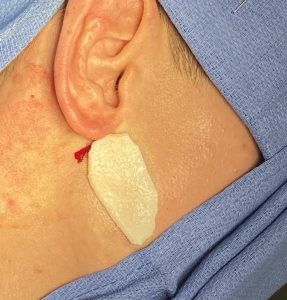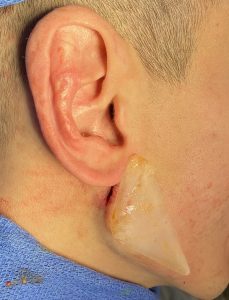One of the potential aesthetic complications of jaw angle implant surgery is masseteric muscle dehiscence. Known also as implant reveal it is when there is lack of muscular coverage over the implanted jaw angle bone, creating a soft tissue contour deformity. This is most seen with jaw movement and chewing as the muscle is activated. This is always a risk in the jaw angle area due to the tight ligamentous attachments of the muscle to the corner of the jaw angle bone.
In jaw angle implant surgery’s whether it is an isolated jaw angle implant or a custom jawline implant, it is necessary to create a subperiosteal pocket. In the creation of this pocket the dissection must go at least to the posterior and inferior borders of the jaw a angle bone. In widening only jaw angle implants it may not always be needed to release these ligamentous attachments so the risk of masseteric muscle dehiscence is less. But when the implant must lengthen the jaw angles ligamentous release is mandatory and the risk of not having muscle coverage over the implant increases.
In the secondary treatment of masseteric muscle dehiscence the logical approach would be for muscle repositioning. Unfortunately this has a low percentage of success and requires an external incision of some length to do so. While this can always be attempted any chance of success is partially dependent on the duration of time from the original implant surgery. Once the muscle is shortened and scarred down the chances of success decrease significantly.
When muscle reattachment surgery fails or is too far out to be successful a camouflage approach of soft tissue augmentation is the only treatment option. Synthetic fillers and fat injections would be the traditional soft tissue fill methods. But when they are inadequate or the patient seeks a more assured permanent option, subcutaneous grafts and implants can be done.
Placed through a small external incisions cadaveric thick dermal grafts (e.g., Alloderm) or a special designed soft tissue jaw angle implant can be done to cover over the contour deformity. Each method has its advantages and disadvantages. As a general guideline in small contour defects a dermal grafts my suffice but in larger contour defects a soft tissue implant works best.


Both the graft and the soft tissue implant are placed through a small incision (1cm) below the ear over the jaw angle area under local anesthesia. This incision permits direct access to the soft tissue defect for optimal positioning through skin flap elevation. The facial nerve branches are well below and above this dissection so this is perfectly safe to do so.
Dr. Barry Eppley
World-Renowned Plastic Surgeon



